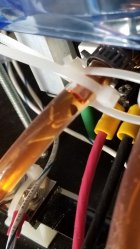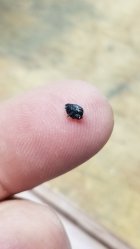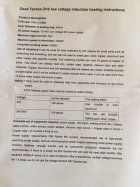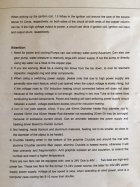You are using an out of date browser. It may not display this or other websites correctly.
You should upgrade or use an alternative browser.
You should upgrade or use an alternative browser.
Induction brass annealer redux
- Thread starter Gina1
- Start date
Nope. I tried anywhere from 7 to 10 turns and none of them worked. Even attached the original coil it came with and it still didn't heat up.That’s a lot of coils! Are they touching each other or the case?
Without really knowing what I was doing I tried several number of turns and diameter of the coil. Looked on You tube and tried some recommendation I found there. I'm starting to think that problem may not be the setup but person doing the setup.I thought there were too many turns also but don't think that would prevent it from working.
Last edited:
Did it. It lasted about 800 6.5 creedmoor cases before it crapped outI'm considering doing one of these.
Need some help, I built one of these and added a case feeder. I was running out to test the case feeder and after about 40 cases the heating started to drop along with the amps. Did an initial inspection and found a little debris had blocked the coolant flow. Trying to figure out if I was pushing it to fast or if it was a coolant flow problem. What kind of a throughput can these boards handle. 







The ZVS board needs an instant-on voltage to start the annealing cycle. The power supply does not come on instantly, it ramps up as it powers on.I actually took the ZVS board out and wired it directly to the 48 volt power source. I placed the placed the ZVS board on top of a block of wood to make sure there were no grounding issues. I powered it up and not heating occurred.
You need some kind of a switch to apply a sharp power spike to the ZVS board from an already active power source.
I don't think they can handle the throughput that you appear to be providing. (I'm assuming that you have some kind of sensor to trigger the next annealing or you are using a short timer delay to allow time for the next case to drop. Either way, it appears to be too fast.)Need some help, I built one of these and added a case feeder. I was running out to test the case feeder and after about 40 cases the heating started to drop along with the amps. Did an initial inspection and found a little debris had blocked the coolant flow. Trying to figure out if I was pushing it to fast or if it was a coolant flow problem. What kind of a throughput can these boards handle.
That blockage probably has little to do with the board dying, as the cooling system has more to do with keeping the coil cool so you don't get burned (and a little to do with heat transfer back into the board through the standoffs, which can also be caused by current running through that connection). If the board got cooked due to heat build up (likely), then you need to either provide better cooling to the board or monitor the temp on the board in order to pause things for cooling.
I also have a case feeder, and my coil was connected to the board with a heavy gage wire (about 3/16" diameter), with a temp sensor attached to the wire, and the heat build up in the wire was so bad from current flow (even with cooling) that I had to set my delay timer cycle between anneals to 80-90 seconds. I am in the middle of a complete re-design and re-build to try to mitigate that problem.
I can run 50 308 cases through mine nearly as fast as it will go. The board will run nearly continuously if you provide enough heat dissipation. Many people use stick on heatsinks under the capacitors these are a major source of heat as are the inductors and the standoff connections I soldered mine to the board and added some wire to the circuit board traces.
It is possible that you got two bad boards however I would be absolutely double checking everything before just plugging another board into your setup. Im sure you have already been over everything at least twice already. The big board killers are getting the full voltage to the board in a instant and connections on the board. Check every solder joint on the board before applying power.
I pulled out the bad board today, looks like a couple components have an issue. Looking them up, they are capacitors, on Amazon for about $1 each. I'm going to try a repair and possibly have a spare boardThanks for the comments, I have a new board arriving today and an additional heat sink. I'll closely monitor the board temps this time around.
Attachments
itchyTF
Gold $$ Contributor
You might want to check the FETs also.I pulled out the bad board today, looks like a couple components have an issue. Looking them up, they are capacitors, on Amazon for about $1 each. I'm going to try a repair and possibly have a spare board
I just received the third ZVS board
I just got the third ZVS board. I've checked the solder joints on the board and far as I can tell they look fine. This particular board came with a specification sheet. Unfortunately the grammar is quite bad. If someone can have a look see just in case I missed something or misunderstood something. I'm running 48V 12.5A Power supply, at least that's what it says on the power supply. I'm going to check my wiring for the umpteenth time before I put the board in. Needles to say I'm a bit nervous because if this still doesn't work I will be out of options.If you’re unsure of what good/bad solder joints are supposed to look like, Google “good solder joint”. Lots of pictures of both.
Attachments
Nothing on those sheets stands out to me as a red flag in the situation that the board is being used for in this project and the circuit that we use.
Although if the max current of your power supply is 12.5 A it may not be enough in all circumstances. But shouldn't cause the failures you have experienced so far.
Although if the max current of your power supply is 12.5 A it may not be enough in all circumstances. But shouldn't cause the failures you have experienced so far.
Should I get a power supply with a higher amperage? Is a single output power supply better than a multi output?Nothing on those sheets stands out to me as a red flag in the situation that the board is being used for in this project and the circuit that we use.
Although if the max current of your power supply is 12.5 A it may not be enough in all circumstances. But shouldn't cause the failures you have experienced so far.
Last edited:
My unit runs at about 11A with no case and with a 308 case nearly 17A starts at about 15 and rises to about 16.7 the voltage is set to 45V. I think you may need a bit more power a lot depends on your coil and the size compared to the case. Most people seem to go with two power supplies on for the 12V components and another for the induction board. That may be down to cost. The 12V power supplies can be quite cheap. I bought mine on Ali Express never had any problems with them. Much cheaper than elsewhere. Your power supply should have enough power to run the board at least to test it. I would test it with the coil provided they are normally much larger and dont draw as much current with no load.
What are the specs of your power supply? 20A? I only run the ZVS board of the 48V 12.5A power Supply. The water pump, radiator fan, and another fan to draw air into the Computer case use a 12V power supply. The fan over the board uses 110V. I used the schematic that Gina1 supplied.My unit runs at about 11A with no case and with a 308 case nearly 17A starts at about 15 and rises to about 16.7 the voltage is set to 45V. I think you may need a bit more power a lot depends on your coil and the size compared to the case. Most people seem to go with two power supplies on for the 12V components and another for the induction board. That may be down to cost. The 12V power supplies can be quite cheap. I bought mine on Ali Express never had any problems with them. Much cheaper than elsewhere. Your power supply should have enough power to run the board at least to test it. I would test it with the coil provided they are normally much larger and dont draw as much current with no load.
Last edited:
Similar threads
- Replies
- 74
- Views
- 47,116
- Replies
- 0
- Views
- 1,563
Upgrades & Donations
This Forum's expenses are primarily paid by member contributions. You can upgrade your Forum membership in seconds. Gold and Silver members get unlimited FREE classifieds for one year. Gold members can upload custom avatars.

Click Upgrade Membership Button ABOVE to get Gold or Silver Status.
You can also donate any amount, large or small, with the button below. Include your Forum Name in the PayPal Notes field.
To DONATE by CHECK, or make a recurring donation, CLICK HERE to learn how.

Click Upgrade Membership Button ABOVE to get Gold or Silver Status.
You can also donate any amount, large or small, with the button below. Include your Forum Name in the PayPal Notes field.
To DONATE by CHECK, or make a recurring donation, CLICK HERE to learn how.












